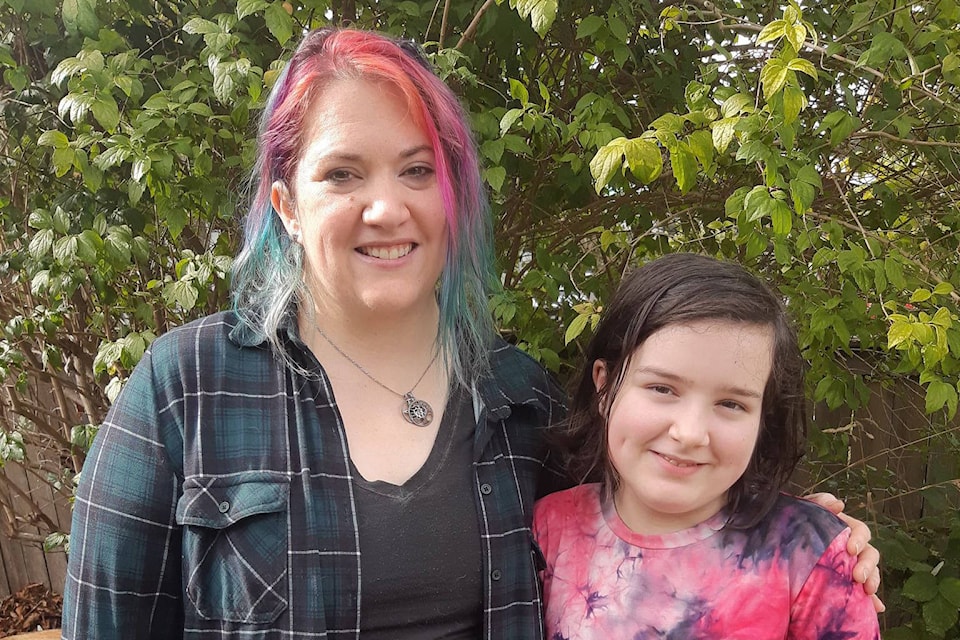A Comox Valley family is urging the government to provide coverage for a breakthrough diabetes monitoring system.
Lisa Christensen’s 11-year-old daughter, Lillithe, was diagnosed with Type 1 diabetes three years ago.
Type 1 diabetes involves continuous monitoring of blood glucose - a finger poke to draw blood, which is then applied to a strip, so a machine can calculate the numbers.
“You must constantly be aware of your blood glucose number, as if it gets too high for too long, you can develop both acute and long-term complications,” said Lisa. “If it gets too low, you are in danger of unconsciousness, or if you do not receive help it could lead to potential death.”
Type 1 diabetics are dependent on insulin, either by syringe or by pump. The glucose monitoring tells the diabetic if insulin is needed.
RELATED: People with diabetes meet their alert dogs
RELATED: Getting kids to a good weight by 13 may help avoid diabetes
Lisa said when the family first began monitoring Lillithe’s glucose levels, a good night’s sleep was not an option.
“In order to be safe, because blood glucose can change quickly for many reasons - especially with children - we had to get up and poke her fingers multiple times a night,” explained Lisa. “We caught some lows this way before they could become dangerous but we were constantly feeling exhausted by the lack of quality sleep and the worry.”
Thanks to a grant from Bear Essentials (Children’s Health Foundation of Vancouver Island), and the Help Fill a Dream Foundation, the family secured funding for a flash glucose monitor, which was a marked improvement, but still had its drawbacks.
“We found that while the quantity of the data greatly improved our experience in treating our daughter’s condition, the results were not always accurate, so we were still doing a lot of finger poke tests to confirm we were dosing off of accurate information,” said Lisa. “A flash monitor does not come with the ability to broadcast your results to a phone or device, it must be physically scanned. This means you still have to get up in the night to go and check on things.”
The Christensens were introduced to a continuous glucose monitor - the Dexcom G6. Administrators of the aforementioned grant program agreed to switch funding over to the Dexcom G6, and Lisa says the switch has been life-changing.
“This is an amazing life- and sanity-saving device,” said Lisa. “The accuracy of the G6 has been pretty much spot on for us, you can dose insulin without the need for painful finger pokes. Because of the transmitting ability of the device, both my husband and I can access the blood glucose at any time on our phones.
“I no longer have to get out of bed to check her numbers at night, and I can rest assured that if numbers climb or fall the G6 will automatically alert me. When she goes over to see a friend, I can keep an eye on her numbers from any distance, and she can call me to get advice on how to treat.”
The government is investigating if this technology could be beneficial enough to warrant providing PharmaCare coverage.
“We need them to say yes,” said Lisa. “It is unconscionable to force people who have to take a medication that has the potential, when dosed incorrectly or affected by activity, to be extremely dangerous to make decisions based off of insufficient and inaccurate data when there is an easy alternative.”
PharmaCare only considers coverage if manufacturers apply to have their products covered by PharmaCare. Every submission is reviewed by the Drug Benefit Council (DBC), an independent advisory body, after which, the DBC will make recommendations to PharmaCare.
When contacted by The VI Free Daily, a Dexcom spokesperson confirmed that “Dexcom Canada has applied to have Dexcom G6 coverage with BC PharmaCare.”
The VI Free Daily has also reached out to the DBC to inquire about whether the board has made a recommendation to the government regarding the G6.
Meanwhile, Lisa said her grant money has run out and the family will have to revert to the poking method to test glucose levels.
“This causes deep anxiety as I am not sure how I will go about finding the funds if the government does not accept the G6 to fair PharmaCare,” she said.
Lisa added that CGM technology is only marginally more expensive than using the outdated technology of strips and the painful finger pokes that the government plan currently covers. She said the upfront costs would pay for themselves over time.
“I would argue that that cost is far more than recovered in the savings from reducing complications and hospital stays in the long run,” she explained. “As well as increasing productivity of type ones and their caregivers who are no longer exhausted by chasing numbers. And perhaps most importantly of all, by reducing the risks of death for people with this manageable, yet potentially dangerous condition.”
For more information on the Dexcom G6 continuous glucose monitoring system, go to www.dexcom.com
For more news from Vancouver Island and beyond delivered daily into your inbox, please click here.
